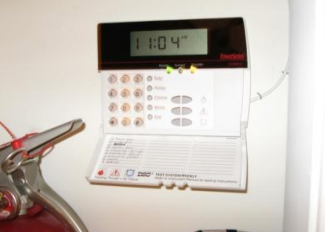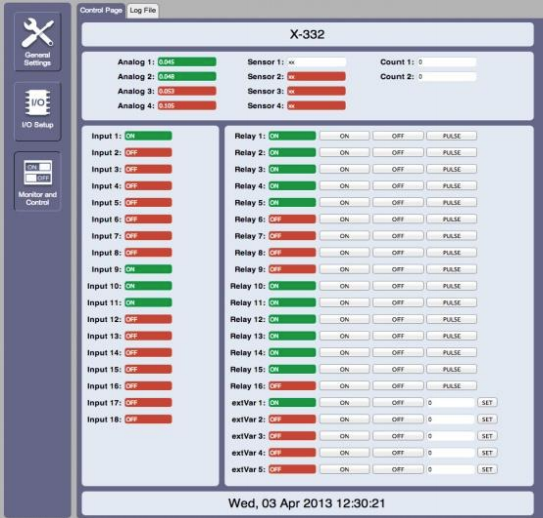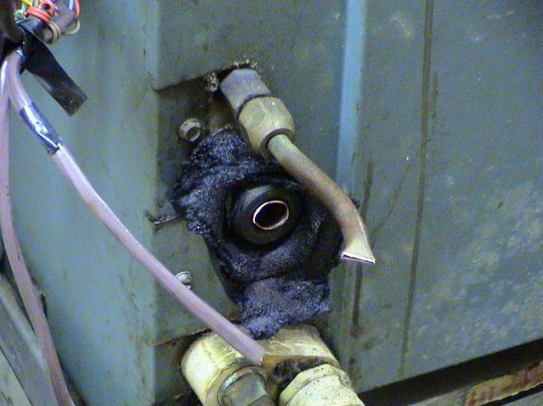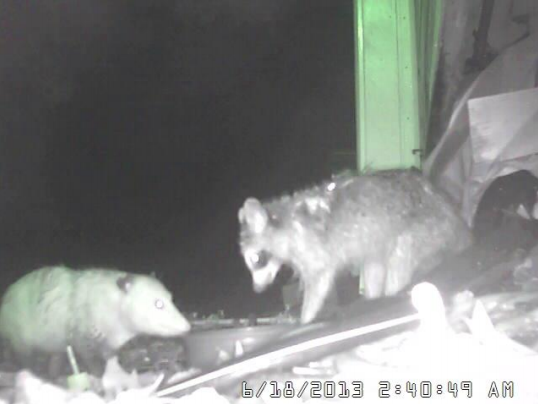Site Security FLAP: A is for Alarms

[September 2014] Although this series was sparked by the increase in thefts of copper from ground systems, the need for site security affects all stations. Whether AM or FM, you do not need vandals ripping out air conditioning coils, or breaking into the building.
In this installment, Kevin Kidd explains some solutions that will work in securing your station.
During our last visit we talked about the L in the acronym FLAP which stands for Lighting.
Along with Fences, Lighting components and various observations are methods that work to keep your site secure. In this installment we will look at the third line of defense: Alarms.
A is for Alarms
As I said, Fences and Lighting are the first letters in our acronym FLAP and are certainly our first lines of defense for transmitter sites.
However, all too often thieves do not understand that there are lines not to be crossed and we have to move on to other strategies. If they have defeated an effective fence and knocked out lighting fixtures, it is pretty clear they are not just out for a midnight stroll.
The point is: after a vandal defeats our first lines of defense we must know that the white flag has flown. At the same time, effective alarms are getting pretty deep into our defensive bag of tricks. When the alarms go off, the bad guys are already there! Then it is up to you how to react.
Alarm Methodology
To best protect sites and our clients’ interests, we recommend that there be two separate alarm systems. Oh, what the heck, make it three if you want to count a video alarm system.
System 1: A professionally installed and monitored system to detect intrusion into the transmitter and ATU buildings or cabinets.

ADT and others provide reliable monitoring service but at a premium price. As an alternative, local alarm instal- 2 lers or cable systems may be able to provide equivalent service at much lower prices.
Have a Pro Install It
The professionally monitored system should encompass all the normal intrusion, motion and smoke detection equipment. Motion or laser line break detectors should be used inside to monitor for vandals who avoided the door/window sensors (possibly by breaking through a wall). And all outlying buildings (ATU, generator, storage, etc.) should be included in the primary alarm perimeter.
A good system should be able to accept multiple access codes that can be assigned to various personnel and contractors as necessary. This to prevent having to notify all authorized personnel when an authorization changes and to know who is coming and going – and when.
Over time, we have found that motion detectors and laser line sensors can cause unacceptable amounts of false alarms in outside and uncontrolled spaces but are very reliable inside. Outside motion detectors may still be useful when monitored by the secondary system.
Since the primary professionally installed system is best designed and installed by “professsionals,” we will spend most of our time here discussing the components of the secondary systems.
Use What You Have
System 2: Conveniently, this can be an extension of your normal transmitter remote control system.
This second system will m onitor secondary sensors and devices that you really would not want to trigger an automatic public safety response.
onitor secondary sensors and devices that you really would not want to trigger an automatic public safety response.
In addition to your normal transmitter monitoring, these secondary sensors would include:
- Area lighting monitors
- Fence monitors
- Outside motion detectors (understand that these are less than 100% reliable)
- Laser line monitors.
- HVAC sensors.
That works fine if you have inputs available. If not, perhaps you can use one of the various IP monitoring solutions.
The following screenshot is from the WebRelay X332 controller from ControlByWeb, priced at about $550.
It has 16 digital inputs, 4 analog inputs, and 4 separate temp sensor inputs. It also provides 16 relay controls that will either pulse or latch.
ControlByWeb has DIN rail boxes with one input and one relay for about $100. Most of the modern WebRelay units will send email alarms based on input conditions, including the site temperature.
Take the time to plan your alarm system carefully. Identify the most vulnerable approaches to your site, and ensure your system is able to react to an intrusion. Let us take a look at some of the alarms that may be useful in protecting your site.
Lighting Alarms
Previously, we discussed how current monitors can be used to determine if there was a lighting failure or intentional damage.
The closures provided by most of the commercial monitor products are suitable for normal alarm purposes. Other current monitor products may provide an analog voltage/current and require external comparators or sensors to provide a usable fault indication.
We also suggest adding an astronomic time switch to verify that lights should be on or off and to disable the alarm function during daylight hours.
HVAC Alarms
Please make sure that your HVAC units are reliably monitored.
Do not be complacent. If you have not had an unprotected HVAC unit destroyed yet, it is not a matter of if it is going to happen, but a matter of when. In fact, the HVAC system may become an early warning device itself.

We have been able to determine that, at some sites, the copper vandalism began with a destroyed HVAC unit.
How do we know? The HVAC unit was completely destroyed but the vandal quickly abandoned the site after he took the station off the air by cutting the main FM feed line. No other damage was evident.
There are numerous HVAC alarm units currently on the market. They range from simple tamper switches that will trigger an alarm if the top is removed all the way up to pressure monitors that monitor the gas pressure and alarm if the system is breached at any point. They may also include a voltage monitor aimed at detecting the loss of a power and/or control cable.
One note: Most of these alarms must be professionally supplied and installed in the pressure lines by HVAC contractors.
At the same time, even a simple alarm in the form of an inconspicuous pair of wires running along with the power cable and control cabling will provide some protection. These wires need to run as a loop to and from the outdoor HVAC unit and connected to a proper alarm input. Cutting either of the loop wires should trigger the alarm.
Your new HVAC alarm can be monitored by either primary or secondary alarm systems (or both) as deemed necessary.
Fence Alarms
There are numerous fence monitoring systems on the market as well.
Most use a special fiber-optic or wire threaded through the fence fabric to detect cutting and fabric movement. These systems might be appropriate for at-risk sites but are probably more expensive and false alarm prone than might be useful for typical applications.
As with the HVAC alarm, a simple closed circuit alarm of a wire (or series of wires) threaded through the fence fabric might be used to provide some warning that the fabric had been cut. This assumes a vandal cuts the “trip” wire.
If you decide to institute a homemade fence alarm, we strongly suggest using a relay as a buffer between the detection loop and the alarm system for lighting protection. Also remember that the detector wire must be rated for outdoor use, be a similar color to the galvanized fabric, and should be a single run, series-looped around the fence posts such that it has to be cut to be removed.
In other words, set it up so that cutting any wire anywhere through the fence fabric stock will trigger the alarm,
Temperature Alarms
There are many reasons why temperature alarms should be incorporated into your site alarm or remote control.
Not only will they provide notification of an HVAC failure but they would also give additional notification or verification of HVAC vandalism.
Bait Copper
We have previously discussed fantasies of connecting a HV source to a fence and watching the fireworks.
I have found myself often having those very same thoughts, usually involving a piece of scrap copper strap and a spare HV transformer. Unfortunately, in reality, this style of site protection has been soundly rejected by my conscience and the legal staff.
On the other hand, a copper thief’s first inclination when finding a loose piece of copper is to puuuulllllll on it, to see if it is connected to any more loot.
With this in mind, a cheap “bait” alarm can be constructed from a scrap piece of copper strap, a couple of feet of stainless cable or wire and a switch. The premise here is that when the copper is pulled, the switch makes (or breaks depending on your preference).
I have used door-type magnetic switches, headlight pull switches, an old set of lawnmower points, a trailer breakaway switch, and various other combinations of junk found lying around to build bait alarm switches.
The bait should be carefully placed such that it is not visible from outside the controlled area. We do not want to create any additional attracttion to the good stuff. Then again, we want the vandal to find the bait before finding the good stuff.
Unfortunately, (or fortunately depending on your point of view) I have never gotten to enjoy the satisfaction of seeing the results of any of these contraptions. The three I have built for myself and local clients have never been pulled or at least had no report thereof.
I even have a portable version that we place at storage containers on job sites. It was built using a battery-operated $5 Harbor Freight magnetic door alarm. We place the bait at a point where the thief has to be pilfering around the containers to see it with the alarm box hid under something convenient.
Video Alarms
System 3: One or more cameras paired with a hard drive will give you a clear view of what is going on when you are not at the site. It may even help the police identify bad guys, in case of theft or vandalism.
Decent IP cameras have been getting cheaper and cheaper. An IP IR camera set that would have cost $1k+ a few years ago now is widely available for less than $200, and some are less than $100.
If you install a few cheap IP cameras with an economical video security suite you have a good basic security system. When coupled with a decent primary alarm and a decent secondary alarm it helps make your sites dramatically safer and more secure.
Some of these systems save video locally, some stream it down the Internet, sending email pictures or video when a motion detector is tripped. Some even include wireless cameras.
One reason that you may wish to consult a local company specializing in video is that you want a system that is not going to be overwhelmed with RFI. If you get a cheap system, you may find the video is not very useful.
As you can see, there is good reason to utilize a combination of all three systems.
Low Cost That Works
We have evaluated several low cost IP video alarm products and, as you would expect, all of them have strengths and weaknesses.
The Foscam (www.foscam.us) IP cameras seem to be the best of the low-priced units – but do watch out for knock-offs with similar names (with a lot of Chinese electronics, there are five knockoffs for each real branded product). Some knockoffs are OK but most are inferior to the real product. Consider: if the camera video is filled with RFI, have you really saved anything?
Official Foscam products have a built-in webserver, and some versions of the firmware allow other similar cameras to be “linked” onto the internal page.
A Sharper Image
A little more money will get you a BlueIris system. BlueIris will monitor most common IP cameras and analog camera adapter cards. It also works with USB cameras.
BI uses various methods of video motion detection and as might be expected, is very reliable in controlled environments, but not so much in uncontrolled areas. Bugs and wind driven debris drive the video detection algorithms absolutely nuts which, in turn, will subsequently drive you nuts if not properly controlled.
We use BI for our secondary security system around the palatial AGSC compound. We monitor our shop, warehouse driveways, doors, cat food dispensers, dog houses, and other important stuff.
With some fiddling of the settings, a good compromise of sensitivity and reliability can be achieved with the motion detection feature. We also record several cameras 24/7 for posterity. BI provides remote viewing and control via a built-in web page. (Control applications for the Android and iPhone are available on their respective Markets.)
BlueIris is quite processor intensive but will work nicely with three or four cameras on most any decent repurposed computer. As you might expect, more cameras will require more horsepower, and motion detection requires even more horsepower than simple recording.
The BI server at our office is a dedicated Intel I7, 3.77 GHz, 8 GB ram, running Win7 Pro64. Monitoring and/or recording 22 cameras (of the potential 64 maximum) consumes about 20% processor and memory. BI will play sounds, send email/text/pix messages and push alerts to smart phone apps on various alarm conditions.
The remote monitor computer requires nothing special other than a network connection to the BlueIris web page. If it were going to be monitored in a studio, I would suggest a large monitor for easy viewing.
BlueIris costs $50
Who to Alert
Now that we have our basic systems in place, who should be tasked to monitor them?
With a professional system it is easy. The alarm company will provide the monitoring and alert functions. They should have a list of contacts that would begin with local public safety and move on to the On-Air Studio, station emergency number, Engineer, PD, GM, etc.
The secondary and video alarms should monitor themselves but alerting may be a little more complicated since each alarm requires different responses based on the factors involved.
For example, not all invaders are copper thieves. Especially in rural areas, but even in cities, the open areas and relative warmth in the winter are quite attractive to the local animal population.
Before they get into your building – or worse, the transmitter – you need to know of their presence.
A single light out is mostly likely just a failure; several lights out for over a few minutes probably are signaling a need to investigate. Throw in a tripped motion detector or HVAC or fence alarm, and you know they’re heeerrrrre!

While most of the alerts noted in this and the previous articles probably will require interacttion with engineering personnel, other station employees with common sense and a little training can certainly learn to check the camera system for unwelcome bodies skulking around, and alert the appropriate responders to handle what is going on. An alert staff just might save you from losses from thieves and vandals.
What’s Next in FLAP?
In the next installment, we will look at P and discuss the value of Presence at our sites.
– – –
Kevin C. Kidd, CSRE/AMD is the proprietor of AM Ground Systems Company and KK Broadcast Engineering.
More information on ground systems and security systems can be obtained by calling Kevin at 1-877-766-2999 or visiting his web site at: www.amgroundsystems.com
